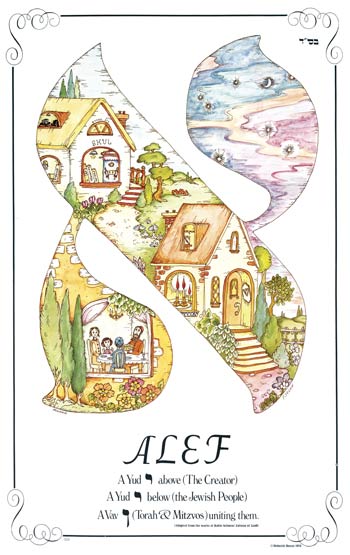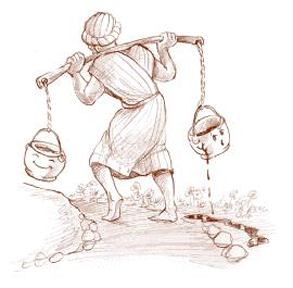Parsha Netzavim, usually read just before Rosh Hashana makes reference to two ancient occupations that are no longer (as) relevant in today’s new economy: wood-choppers and watercarriers. Earlier this year we learned inspiration from log-splitting after a visit to Dippikill in the Adirondacks, so this time we’ll speak about watercarriers.
The Previous Lubavitcher Rebbe, Rebbe Yosef Yitzchak once shared a memory from his youth, that his childhood teacher Reb Yekusiel told them that the Hebrew letter Alef resembles a watercarrier for it has a middle pole that carries a bucket on either side. The Rebbe explained the value of this educational technique: Whenever a child would encounter a watercarrier (then commonplace), he’d think: ah, an aleph! How many of us go out into the world and encounter our studies, see the world as a reflection of what we’ve learned? This is inspired education in the fashion of the Baal Shem Tov and the ways of the Rebbes of Chabad, and one that inspires me all the time.
 Speaking of the Aleph as a watercarrier, and how the form of the letter itself conveys a message here’s a memory from my youth. For 10 years, from 1978-1988, my father Rabbi Rubin and Capital Chabad operated “Kosher Pizza and Felafel” at 483 Washington Ave. The neighborhood has changed considerably but you can still see the curved-top Jerusalem-esque door and window archways on the first floor of that building between Quail and Lake. The business was a spiritual one for financially it often operated at loss, but many people have many fond memories of the place, including myself. (In fact, right after I shared this, a student told of me of a COO in Jerusalem who got his Jewish start at that Pizza shop, and there are many such stories!) One particular image stands out tonight. Over the bright blue naugahyde bnenches, on the wooden wall paneling, between the Captains light sconces, there was this framed Alef poster, a classic piece of artwork by Michoel Muchnik. This tells the story of what the Alter Rebbe, first Rebbe of Chabad said to his son’s school-teacher: “A Yud from above (the Creator) and a Yud below (that’s us) and a line of Torah and Mitzvot in between – that’s an Aleph!” Muchnik’s art puts a starry sky in the upper Yud, a family in their home in the lower Yud, and Jewish institutions and observance in the middle.
Speaking of the Aleph as a watercarrier, and how the form of the letter itself conveys a message here’s a memory from my youth. For 10 years, from 1978-1988, my father Rabbi Rubin and Capital Chabad operated “Kosher Pizza and Felafel” at 483 Washington Ave. The neighborhood has changed considerably but you can still see the curved-top Jerusalem-esque door and window archways on the first floor of that building between Quail and Lake. The business was a spiritual one for financially it often operated at loss, but many people have many fond memories of the place, including myself. (In fact, right after I shared this, a student told of me of a COO in Jerusalem who got his Jewish start at that Pizza shop, and there are many such stories!) One particular image stands out tonight. Over the bright blue naugahyde bnenches, on the wooden wall paneling, between the Captains light sconces, there was this framed Alef poster, a classic piece of artwork by Michoel Muchnik. This tells the story of what the Alter Rebbe, first Rebbe of Chabad said to his son’s school-teacher: “A Yud from above (the Creator) and a Yud below (that’s us) and a line of Torah and Mitzvot in between – that’s an Aleph!” Muchnik’s art puts a starry sky in the upper Yud, a family in their home in the lower Yud, and Jewish institutions and observance in the middle.
Back to watercarriers. How do you get the water to fill the bucket? What needs to be done? (Many present made a similar dipping motion…) The whole bucket has to be dunked into the water, totally immersed, and then withdrawn with the water still inside. It’s the same with refreshing spiritual waters. Going all the way in, allows us to get enough water inside us to take out with us. This can be analogous to the upcoming month of holidays: Rosh Hashanah, Yom Kippur and Sukkot. We go all the way in, deep inside, to fill up and take this life-giving and refreshing spiritual nourishment with us all year. Especially on Sukkot when we literally are totally immersed in it, in more ways than one, from all sides!
 Let’s close with an well-known and beloved Indian (or maybe Chinese) parable. A man (or woman) lived atop a hill and the well was at the bottom. Each day he’d go down with two buckets at two ends of a pole, draw water from the well in these two buckets and make the trek back home again. The left-side bucket was perfect, but the right-side bucket had a slight crack in its side. One day, after years of trips up that hill, the cracked bucket spoke up. The cracked bucket felt sorry for the man, because the effort was the same, but due to the crack in his wall, the man didn’t get the full results from his bucket. Due to the crack, some of the water leaked out every day on the way up the hill. He was deeply apologetic for his flaw. The man was reassuring. He showed the cracked bucket the path that led from the well to the home. All along the right side flowers had blossomed (that leakage produced beauty) while the left side (with the perfect leak-proof bucket) nothing grew.
Let’s close with an well-known and beloved Indian (or maybe Chinese) parable. A man (or woman) lived atop a hill and the well was at the bottom. Each day he’d go down with two buckets at two ends of a pole, draw water from the well in these two buckets and make the trek back home again. The left-side bucket was perfect, but the right-side bucket had a slight crack in its side. One day, after years of trips up that hill, the cracked bucket spoke up. The cracked bucket felt sorry for the man, because the effort was the same, but due to the crack in his wall, the man didn’t get the full results from his bucket. Due to the crack, some of the water leaked out every day on the way up the hill. He was deeply apologetic for his flaw. The man was reassuring. He showed the cracked bucket the path that led from the well to the home. All along the right side flowers had blossomed (that leakage produced beauty) while the left side (with the perfect leak-proof bucket) nothing grew.
This may be an Indian or Chinese legend, and watercarriers a thing of the past, but its wise message is timeless and ever-relevant. We each carry a number of buckets in our lives. Some of those buckets may be quite good, but no one has all perfect buckets on their life’s journey. Our cracks may be of different sizes and shapes, we may deal with them in different ways, but we all have cracks in our bucket.
And as we say in the Rosh Hashanah prayer: “we are as Cheres HaNishbar broken pottery!”
